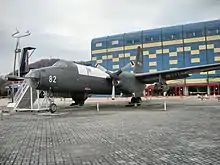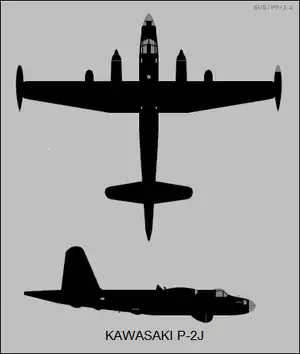| P-2J Neptune | |
|---|---|
 | |
| A UP-2J | |
| Role | ASW and maritime patrol aircraft |
| National origin | Japan/United States |
| Manufacturer | Lockheed Kawasaki Aerospace Company |
| First flight | 21 July 1966 |
| Introduction | 1969 |
| Retired | 1996 |
| Primary user | Japan Maritime Self-Defense Force |
| Produced | 1966-1979 |
| Number built | 83 |
| Developed from | Lockheed P-2 Neptune |
The Kawasaki P-2J (originally P2V-Kai) is a maritime patrol and ASW aircraft developed for the Japan Maritime Self-Defense Force. A turboprop-powered version of the radial-engined P-2 Neptune, the P-2J was developed as an alternative to buying the larger and more expensive P-3 Orion, which would eventually replace the P-2J in the 1980s.
Design and development
The Kawasaki-built P-2J (originally P2V-Kai, where "Kai" (改) means modification) was the last version of the Neptune to be produced. Work on the P-2J was begun in 1961.[1] The first P-2J, converted from a P2V-7 (P-2H) performed its initial flight on 21 July 1966, and the last of a further 82 production P-2Js was delivered in March 1979.[2]
The Wright radial engines of the Lockheed P-2s were replaced with 2,125 kW (2,850 HP) Ishikawajima-Harima T64-IHI-10 turboprop engines, using three-bladed propellers instead of the four-bladed units of late-model P-2s.[3] The Ishikawajima-Harima J3-IHI-7C booster turbojets, produced 13.7 kN (3,085 lbf) thrust, giving the P-2J a top speed of 650 km/h (400 mph).

The P-2J had accommodations for up to 12 crewmen.[3] The forward fuselage was extended 4 feet 3 inches (1.30 m), with the tail surfaces being enlarged and their shape modified. AN/APS-80 search radar was fitted in a smaller radome. Updated avionics systems were installed, and these systems were much more compact than those used in other versions of the Neptune. The lighter avionics load permitted greater fuel capacity. The P-2J's main gear was fitted with two wheels each, rather than the one large wheel of the earlier models.[3]
Operational history
The P-2J was phased out in the 1980s in favor of the P-3C Orion,[3] which eventually replaced the Neptune in the ocean-patrol air fleets of the West. The last maritime reconnaissance squadron re-equipped with the Orion in 1993, but the P-2J remained in service for electronic reconnaissance and target support purposes.[4]
Variants

- P-2J
- Originally called the P2V-Kai
- T64 turboprop engines, IHI J3 engine pods, improved ASW/ECM gear, APS-80 search radar standard, increased fuel capacity, various other improvements; 1 converted from a P-2H, and 82 new-builds.
- EP-2J
- P-2J converted for electronic intelligence gathering. Two converted.[2][3]
- UP-2J
- P-2J converted for drone support, target towing and test purposes. Four converted.[3][4]
Operators
Specifications (P-2J)

Data from Combat Aircraft since 1945[3]
General characteristics
- Crew: 10-12
- Length: 29.23 m (95 ft 11 in)
- Wingspan: 30.87 m (101 ft 3 in)
- Height: 8.93 m (29 ft 4 in)
- Wing area: 92.9 m2 (1,000 sq ft)
- Airfoil: root: NACA 2419 mod.; tip: NACA 4410.5[5]
- Empty weight: 19,278 kg (42,501 lb)
- Max takeoff weight: 34,020 kg (75,001 lb)
- Powerplant: 2 × Ishikawajima-Harima T64-IHI-10 turboprop engines, 2,125 kW (2,850 hp) each
- Powerplant: 2 × Ishikawajima-Harima J3-IHI-7C turbojet engines, 13.7 kN (3,100 lbf) thrust each (boosters for take-off and combat)
- Propellers: 3-bladed constant-speed fully-feathering reversible-pitch propellers
Performance
- Maximum speed: 650 km/h (400 mph, 350 kn)402
- Ferry range: 4,445 km (2,762 mi, 2,400 nmi)
- Service ceiling: 9,150 m (30,020 ft)
- Rate of climb: 9.133 m/s (1,797.8 ft/min)
Armament
- Rockets: 16 x 5 in rockets under the wings
- Bombs: 3,629 kg (8,001 lb) including free-fall bombs, depth charges, and torpedoes
See also
Related development
Aircraft of comparable role, configuration, and era
Related lists
References
- Donald, David; Lake, Jon, eds. (1996). Encyclopedia of World Military Aircraft (Single volume ed.). London: Aerospace Publishing. ISBN 1-874023-95-6.
- Michell, Simon (1994). Jane's Civil and Military Aircraft Upgrades 1994-95. Coulsdon, Surrey, UK: Jane's Information Group. ISBN 0-7106-1208-7.
- Taylor, John W. R. (1966). Jane's All The World's Aircraft 1966–67. London: Sampson Low, Marston & Company.
- Sullivan, Jim, P2V Neptune in action. Squadron/Signal Publications: Carrollton, TX, 1985.
- Wilson, Stewart (2000). Combat Aircraft since 1945. Fyshwick, ACT, Australia: Aerospace Publications Pty Ltd. ISBN 1-875671-50-1.